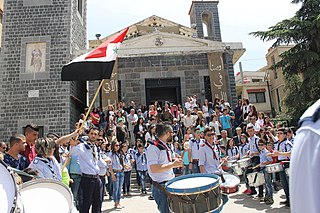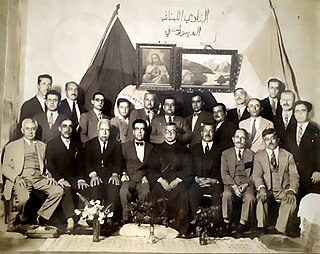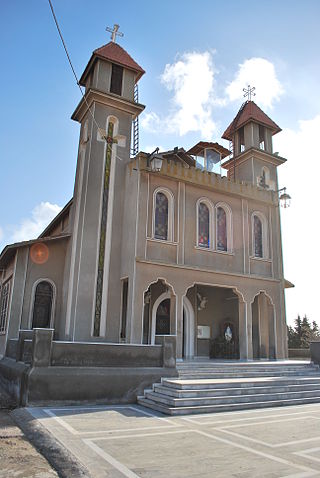| Total population | |
|---|---|
| 1940s (peak time): 40,000 to 131,000;[ citation needed ] 2000's: 5,000 | |
| Regions with significant populations | |
| Mostly Cairo and Alexandria. Formerly also Mansoura, Port Said, Tanta, Suez | |
| Languages | |
| Arabic, French | |
| Religion | |
| |
| Related ethnic groups | |
| Lebanese people, Lebanese diaspora, Lebanese American, Lebanese Argentine, Lebanese Brazilian, Lebanese Canadians, Lebanese Mexican, Lebanese Colombian |
The Lebanese people of Egypt are people from Lebanon or those of Lebanese descent who live or have lived in the country of Egypt. Many prominent figures that have emerged in Egypt were of Lebanese origin, such as the world-famous actor, Omar Sharif (born Michel Chalhoub), and the highly acclaimed Egyptian filmmaker, Youssef Chahine. Most Lebanese who resided in Egypt were highly educated, and the community as a whole contributed to both Egypt's cultural and financial well-being, especially during the era of the Muhammad Ali dynasty. Since the Egyptian Revolution of 1952, most of Egypt's Lebanese community left the country immigrating to the Americas, Europe, and Australia, as well as many returning to their native Lebanon (especially Beirut).
The height of Lebanese immigration into Egypt occurred between the 19th and early 20th centuries. As Lebanon was part of Ottoman Syria during this time, Christians from all over the Levant (modern-day Syria, Lebanon, and Palestine) were immigrating to Egypt as one "Shawam" (شوام), or "Levantine" group. [1] Hence, an umbrella term for their community is "Syro-Lebanese". The number of Lebanese Christians in Egypt grew drastically during the 1860 Lebanon conflict, in which thousands of Christians were killed along with hundreds of their villages destroyed. The vast majority of Lebanese and other Levantine migrants who arrived in Egypt were well-educated and French-speaking.
The historic Lebanese community of Egypt, especially during the 19th and early 20th centuries, was almost exclusively Christian (Melkite Greek Catholic, Greek Orthodox, and Maronite Catholic), with small numbers of Muslims and Jews among them.

This is a demography of the population of Lebanon including population density, education level, health of the populace, economic status, religious affiliations and other aspects of the population.

The Levant is an approximate historical geographical term referring to a large area in the Eastern Mediterranean region of West Asia and core territory of the political term Middle East. In its narrowest sense, which is in use today in archaeology and other cultural contexts, it is equivalent to Cyprus and a stretch of land bordering the Mediterranean Sea in western Asia: i.e. the historical region of Syria, which includes present-day Israel, Jordan, Lebanon, Syria, the Palestinian territories and most of Turkey southwest of the middle Euphrates. Its overwhelming characteristic is that it represents the land bridge between Africa and Eurasia. In its widest historical sense, the Levant included all of the Eastern Mediterranean with its islands; that is, it included all of the countries along the Eastern Mediterranean shores, extending from Greece in Southern Europe to Cyrenaica, Eastern Libya in Northern Africa.

The Latin Church of the Catholic Church has several dispersed populations of members in the Middle East, notably in Turkey, Cyprus and the Levant. Latin Catholics employ the Latin liturgical rites, in contrast to Eastern Catholics who fall under their respective church's patriarchs and employ distinct Eastern Catholic liturgies, while being in full communion with the worldwide Catholic Church. Latin Catholics in the Middle East are often of European descent, particularly from the medieval Crusader era and later the 20th-century colonial period.

Arab Christians are ethnic Arabs, Arab nationals, or Arabic-speakers who follow Christianity. The number of Arab Christians who live in the Middle East was estimated to be between 10 and 15 million. Arab Christian communities can be found throughout the Arab world, but are concentrated in the Eastern Mediterranean region of the Levant and Egypt, with smaller communities present throughout the Arabian Peninsula and North Africa.

The phenomenon of large-scale migration of Christians is the main reason why Christians' share of the population has been declining in many countries. Many Muslim countries have witnessed disproportionately high emigration rates among their Christian minorities for several generations. Today, most Middle Eastern people in the United States are Christians, and the majority of Arabs living outside the Arab World are Arab Christians.

Arab Brazilians are Brazilian citizens of Arab ethnic, cultural, linguistic heritage and identity. The majority of Arab Brazilians trace their origin to the Levantine region of the Arab World, known in Arabic as Bilad al-Sham, primarily from Lebanon and Syria, as well as Palestine. Arab Brazilians are Christians in the great majority. The first Syrians and Lebanese arrived in São Paulo around 1880. It is not known exactly when, although the Syrians and Lebanese say that in 1885 there was a small core of peddlers working in the market square. By 1920, the census listed 50,246 Syrians and Lebanese in Brazil, 38.4% (2/5) of these in the state of São Paulo. The 1940 census enumerated 48,614 Syrians, Lebanese and other related groups with a decrease of approximately 1647 people. As immigration almost ceased after 1929 and the colony aged, it is surprising that the decline was not even greater. The trend of the period between 1920 and 1940 was the continuous concentration of Syrians and Lebanese in São Paulo. Almost half (49.3%) of Syrians and Lebanese residents in Brazil lived in São Paulo.

Christianity in Lebanon has a long and continuous history. Biblical Scriptures show that Peter and Paul evangelized the Phoenicians, whom they affiliated to the ancient Patriarchate of Antioch. Christianity spread slowly in Lebanon due to pagans who resisted conversion, but it ultimately spread throughout the country. Even after centuries of Muslim rule, it remains the dominant faith of the Mount Lebanon region and has substantial communities elsewhere.

Antiochian Greek Christians are an ethnoreligious Eastern Christian group native to the Levant. They are either members of the Greek Orthodox Church of Antioch or the Melkite Greek Catholic Church, and they have ancient roots in what is now Syria, Lebanon, Palestine, Jordan, the southern Turkish province of Hatay, which includes the city of Antakya —one of the holiest cities in Eastern Christianity, and Israel. Many of their descendants now live in the global Near Eastern Christian diaspora. They primarily speak Levantine Arabic, with Maaloula near Damascus being one of the few places where a Western Aramaic dialect is still spoken.
Armenians in the Middle East are mostly concentrated in Iran, Lebanon, Cyprus, Syria, Jordan, Saudi Arabia and Jerusalem, although well-established communities exist in Iraq, Egypt, Turkey and other countries of the area including, of course, Armenia itself. They tend to speak the western dialect of the Armenian language and the majority are adherents of the Armenian Apostolic Church, with smaller Catholic and Protestant minorities. There is a sizable Armenian population in the thousands in Israel. There is also the Armenian Quarter in Jerusalem with a history that goes back 2,000 years.

Syrians are the majority inhabitants of Syria, indigenous to the Levant, who have Arabic, especially its Levantine dialect, as a mother tongue. The cultural and linguistic heritage of the Syrian people is a blend of both indigenous elements and the foreign cultures that have come to rule the land and its people over the course of thousands of years. By the seventh century, most of the inhabitants of the Levant spoke Aramaic. In the aftermath of the Muslim conquest of the Levant in 634, Arabic became the dominant language, but a minority of Syrians retained Aramaic, which is still spoken in its Syriac and Western dialects.

Christianity, which originated in the Middle East during the 1st century AD, is a significant minority religion within the region, characterized by the diversity of its beliefs and traditions, compared to Christianity in other parts of the Old World. Christians now make up approximately 5% of the Middle Eastern population, down from 13% in the early 20th century. Cyprus is the only Christian majority country in the Middle East, with Christians forming between 76% and 78% of the country's total population, most of them adhering to Eastern Orthodox Christianity. Lebanon has the second highest proportion of Christians in the Middle East, around 40%, predominantly Maronites. Egypt has the next largest proportion of Christians, at around 10% of its total population. Copts, numbering around 10 million, constitute the single largest Christian community in the Middle East.
Arab Mexicans are Mexican citizens of Arab ethnic lineage, who identify themselves as Arab. Some of Mexico's Arabs are of Lebanese.

Ethnic groups in the Middle East, in the 'transcontinental' region which is commonly a geopolitical term designating the intercontinental region comprising West Asia without the South Caucasus, and also comprising Egypt in North Africa. The region has historically been a crossroad of different cultures and languages. Since the 1960s, the changes in political and economic factors have significantly altered the ethnic composition of groups in the region. While some ethnic groups have been present in the region for millennia, others have arrived fairly recently through immigration. The largest socioethnic groups in the region are Arabs, Turks, Persians, Kurds, and Azerbaijanis but there are dozens of other ethnic groups that have hundreds of thousands, and sometimes millions of members.
Arab Argentine refers to Argentine citizens or residents whose ancestry traces back to various waves of immigrants, largely of Arab ethnic, cultural and linguistic heritage and/or identity originating mainly from what is now Lebanon and Syria, but also some individuals from the twenty-two countries which comprise the Arab world such as Palestine, Egypt and Morocco. Arab Argentines are one of the largest Arab diaspora groups in the world.

Bassir is a village in Hauran, located 630 meters above sea level and 51 kilometers (32 mi) southern of Damascus in Syria. Bassir is bordered from the east by Lejah, from the south by Khabab, from the west by Al-Sanamayn and from the north by Jebab. It is situated in the middle of three main cities in Syria: Damascus, Daraa and As-Suwayda.
Semaan is a Christian surname mainly found in the Levant area of the Middle East. It is derived from the Semitic root word/verb sema or shema, which means “to hear”; thus, the meaning of Semaan becomes “the one who hears or listens” in both Syriac Aramaic and Arabic. Its equivalent in Hebrew is שִׁמְעוֹן, which also has the same meaning. The Greek transliteration is Σιμων (Simon) or Συμεών (Symeon), and, when Latinized, it becomes Simon or Simeon.

The Syro-Lebanese of Egypt, also known as Levantine-Egyptians or Syro-Egyptians, are an ethnic minority group in Egypt. They are Egyptians who have ancestry originating from the Levant, mostly what is now Syria and Lebanon, but also including those from Palestine. The majority of Egypt's historic Syro-Lebanese community is Christian, mainly Greek Orthodox and Eastern Catholic.

The city of New York City includes a large Syrian population. New York City's Syrian community was historically centered in Manhattan's Little Syria, but is now centered in Brooklyn. Historically, Syrians in New York City were predominantly Christian. In the modern era, the city is home to the world's largest Syrian-Jewish community outside of Israel. 75,000 Syrian Jews live in New York City, mostly in Brooklyn. New York City is also home to a smaller community of Syrian Muslims who have lived in the city for over a century, most of whom have immigrated since the 1960s.
Lebanese Nigerians are Nigerians with Lebanese ancestry, including Lebanese-born immigrants to Nigeria. With a population approximated between 30,000 and 100,000, the group form one of the largest communities originally from outside Nigeria.
{{cite journal}}: Cite journal requires |journal= (help)